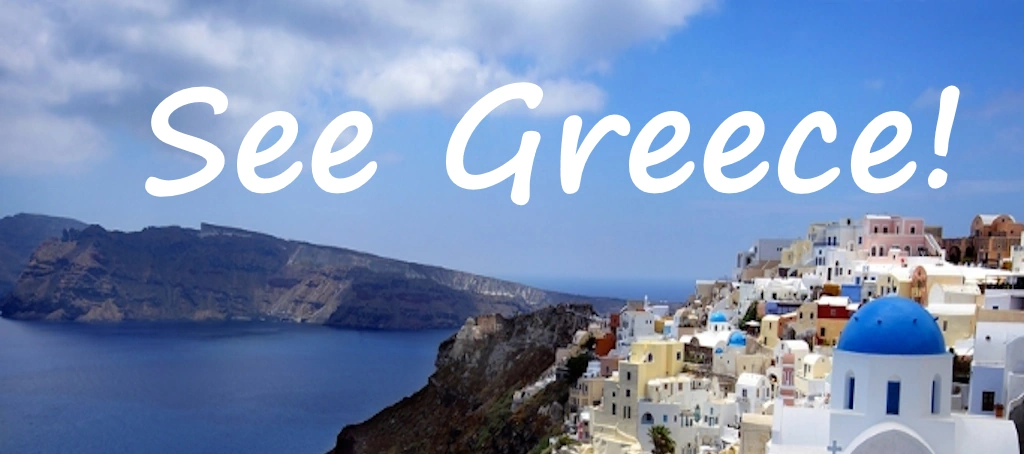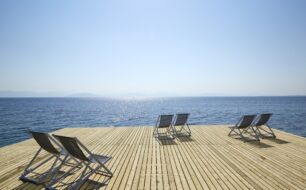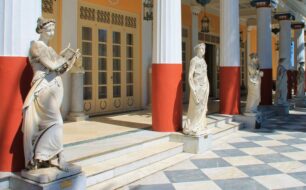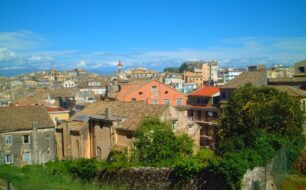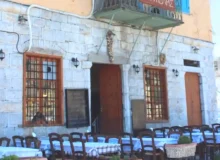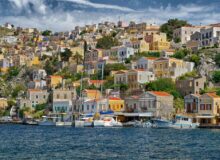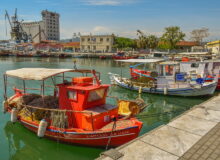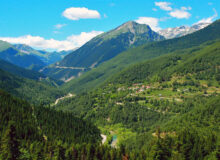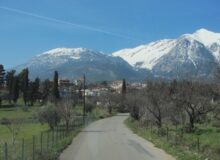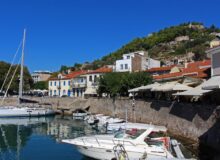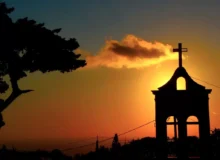The See Greece guide to the island of Corfu with a brief history and travel information on how to get there by ferry or by air and what to see and do.

Introduction
Corfu (Greek: Κέρκυρα, Kerkyra) is one of Greece’s most enchanting islands, known for its lush landscapes, Venetian architecture, and crystal-clear waters. Located in the Ionian Sea off the northwest coast of Greece, Corfu boasts a unique blend of Greek, Venetian, French, and British influences, making it a fascinating destination for history buffs, beach lovers, and food enthusiasts alike.
This guide covers everything you need to know before visiting Corfu, including its location, history, top attractions, best time to visit, and how to get there by air and ferry.
Where is Corfu Located?

Corfu is the northernmost of the Ionian Islands, situated in the Adriatic Sea near the border between Greece and Albania. Its strategic location has made it a historically significant outpost for various empires.
– Coordinates: 39.6243° N, 19.9217° E
– Closest Mainland City: Igoumenitsa (Greece) – about 30km east
– Distance from Athens: ~600km northwest
– Neighboring Islands: Paxos, Antipaxos
Corfu’s coastline stretches over 217km, offering a mix of sandy beaches, hidden coves, and dramatic cliffs. The island’s interior is covered in olive groves, cypress trees, and vineyards, giving it the nickname “The Emerald Isle.”
A Brief History of Corfu
Corfu’s rich history has been shaped by multiple civilizations, each leaving its mark on the island’s culture and architecture.
Ancient Times & Byzantine Rule
– Corfu was first mentioned in Homer’s Odyssey as the island of the Phaeacians, where Odysseus was shipwrecked.
– In 734 BC, the Corinthians colonized the island, establishing the ancient city of Corcyra (modern-day Corfu Town).
– Later, it became part of the Roman and Byzantine Empires.
Venetian Influence (1386–1797)
– The Venetians ruled Corfu for over 400 years, fortifying the island against Ottoman invasions.
– They introduced olive trees, citrus groves, and built the iconic Old Fortress and New Fortress in Corfu Town.
French & British Rule (19th Century)
– Napoleon’s forces briefly occupied Corfu in the early 1800s.
– The British took control in 1815, adding neoclassical buildings, such as the Palace of St. Michael and St. George, and constructing roads and an efficient administration system.
Modern Corfu (1864–Present)
– In 1864, Corfu was united with Greece.
– Today, it is a popular tourist destination, known for its UNESCO-listed Old Town, stunning beaches, and vibrant culture.

What to See & Do on Corfu
1. Explore Corfu Town (Kerkyra)
A UNESCO World Heritage Site, Corfu Town is a maze of narrow alleys, Venetian mansions, and French-inspired arcades (Liston). Key attractions include:
– Old Fortress – A Venetian-era fortress with panoramic views.
– Spianada Square – The largest square in Greece, hosting cricket matches (a British legacy).
– Saint Spyridon Church – Home to the relics of Corfu’s patron saint.
– Palace of St. Michael and St. George – A British-built palace housing the Museum of Asian Art.
2. Visit Achilleion Palace

Built in 1890 for Empress Elisabeth of Austria (Sisi), this neoclassical palace is dedicated to the Greek hero Achilles. The gardens offer breathtaking views of the Ionian Sea.
3. Relax at Corfu’s Best Beaches
– Paleokastritsa – Famous for its turquoise waters and the nearby Monastery of the Virgin Mary.
– Glyfada – A sandy beach with beach bars and water sports.
– Canal d’Amour (Sidari) – A unique rock formation with natural canals.
– Agios Gordios – A scenic beach surrounded by cliffs.
4. Take a Boat Trip to Paxos & Antipaxos

These small islands near Corfu are known for their stunning blue caves and secluded beaches.
5. Discover Hidden Villages
– Pelekas – A hilltop village with a stunning sunset viewpoint.
– Lakones – Offers the famous “Bella Vista” panoramic view.
– Kassiopi – A charming fishing village with a Byzantine castle.
6. Hike Mount Pantokrator

The highest point on the island (906m) offers sweeping views of Albania and the surrounding islands.
7. Enjoy Corfiot Cuisine
Don’t miss:
– Pastitsada – A spicy beef or rooster pasta dish.
– Sofrito – Veal in a white wine and garlic sauce.
– Kumquat liqueur – A local citrus-based drink.

Best Time to Visit Corfu
See our full page on the Best Time to Visit Corfu, but here’s a potted summary season by season.
Peak Season (June–August)
– Weather: Hot (25–35°C) and sunny.
– Pros: Lively atmosphere, all attractions open.
– Cons: Crowded beaches, higher prices.
Shoulder Season (April–May & September–October)
– Weather: Mild (18–28°C), ideal for sightseeing.
– Pros: Fewer crowds, lower prices, pleasant sea temperatures.
– Cons: Some beach bars may close in late October.
Off-Season (November–March)
– Weather: Cool (10–18°C), occasional rain.
– Pros: Authentic local experience, budget-friendly.
– Cons: Limited ferry schedules, some hotels closed.
Best for: Beach lovers (June–September), hikers & culture seekers (April–May & September–October).

How to Get to Corfu
By Air
Corfu International Airport (CFU) receives flights from:
– European cities (London, Berlin, Amsterdam, etc.) via airlines like EasyJet, Ryanair, TUI.
– Athens (45-min flight, operated by Aegean Airlines & Olympic Air).
Airport to Corfu Town: 10-min taxi ride or public bus.
By Ferry
Corfu is well-connected to mainland Greece and Italy.
From Greece:
– Igoumenitsa (30–90 min) – Frequent ferries with Kerkyra Lines & Ionian Seaways.
– Patras (6–7 hours) – Overnight ferries available.
From Italy:
– Venice, Ancona, Bari (8–20 hours) – Operated by Minoan Lines, Anek Superfast.
Inter-island Ferries:
– Paxos (1 hour) – Daily boats from Corfu Town.
Final Tips for Visiting Corfu
– Rent a car or scooter to explore remote beaches and villages.
– Try local wines from Theotoky Estate.
– Visit in early September for the best balance of weather and crowds.
– Learn a few Greek phrases – English is widely spoken but locals appreciate the effort!
